What is Goddess Ganga (river) history (information) (facts)
Namaste friends, how are you doing today? Welcome to #BhagavanBhakthi website / blog.
Bhagavan Lord Sri Vishnu and Goddess Sri Ganga Devi blessings to you and your family!
In this website / blog, you will always learn about #Hinduism #Sanskrit language.
Also subscribe to my YouTube channel from this link #BhagavanBhakthi to view videos about #Hinduism #Sanskrit language.
Just before going to “What is Goddess Ganga (river) history (information) (facts)“, let us know few basic and important information.

In this post you will know the following (contents):
List of Goddess Ganga (river) history (information) facts | Information about the importance of Ganga river to Hindus |
Information about the importance of Ganga River (Goddess Sri Ganga Devi) to Indians | Where do the bones immersed in the Ganges (Ganga river) go? |
Where do the bones go after immersing in Ganga river? | Hindu Puranas / Puranic citation and reference about Goddess Sri Ganga Devi (Ganga River) |
Various Hindu pilgrimages (sacred places) and divine pilgrimage centers located at the riverside of Ganga River |
Symbolism of Goddess Sri Ganga Devi (River) | Dharmic (religious) and Spiritual significance Goddess of Sri Ganga Devi (Ganga River) |
Taking bath in Ganga River especially during Parva Kaala (Kaal) | Dharmically (religiously) and spiritually, taking a bath in the most auspicious and sacred Ganga River |
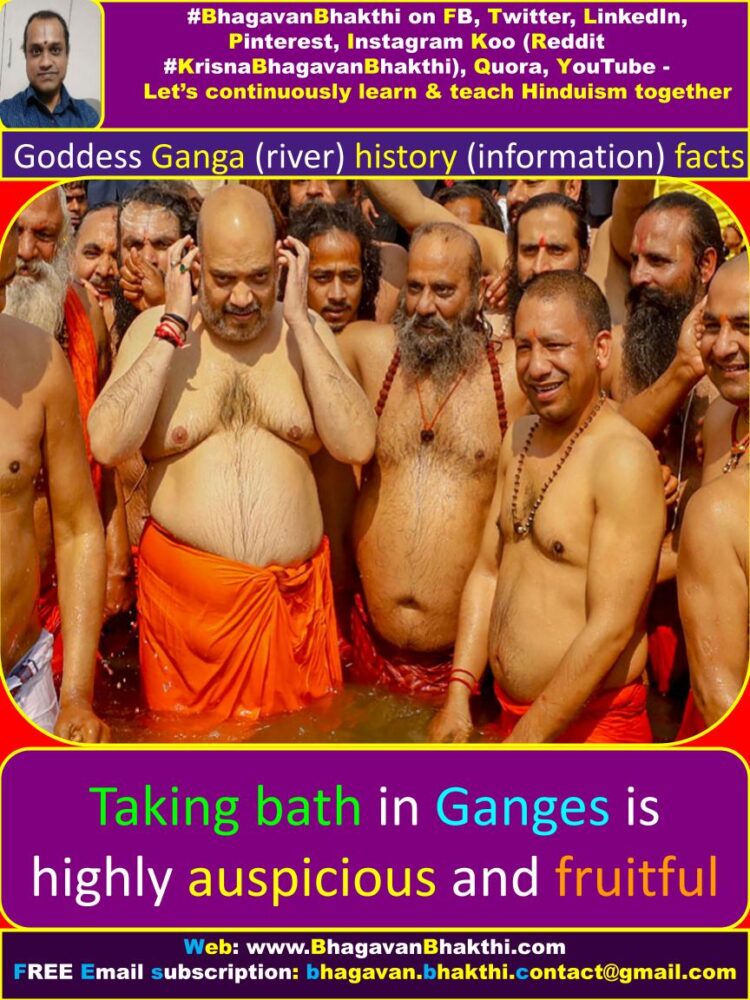
An important custom river to Ganga River among Hindus |
Lord Sri Krishna mentions in his famous preaching of Bhagavad Gita, that is, in Vibhuthi Yoga (10th chapter, shloka #31) |
Ways of worship of Goddess Sri Ganga Devi (Ganga River) | More information about Goddess Sri Ganga Devi (Ganga River) |
Major tributaries Ganga River | Different names of Goddess Ganga Devi | Festivals related to Goddess Sri Ganga Devi (Ganga River) |
The most holiest of tirthas (rivers) is the confluence of the rivers Ganga, Yamuna and Sarasvati. The confluence place is called as Prayagraj or Prayaga or Prayag or Sangama or Sangam.
(Here Ganga and Yamuna rivers are visible, but Sarasvati river flows as ‘Guptagamini‘, that is, she flows beneath and is not visible to ordinary humans.)
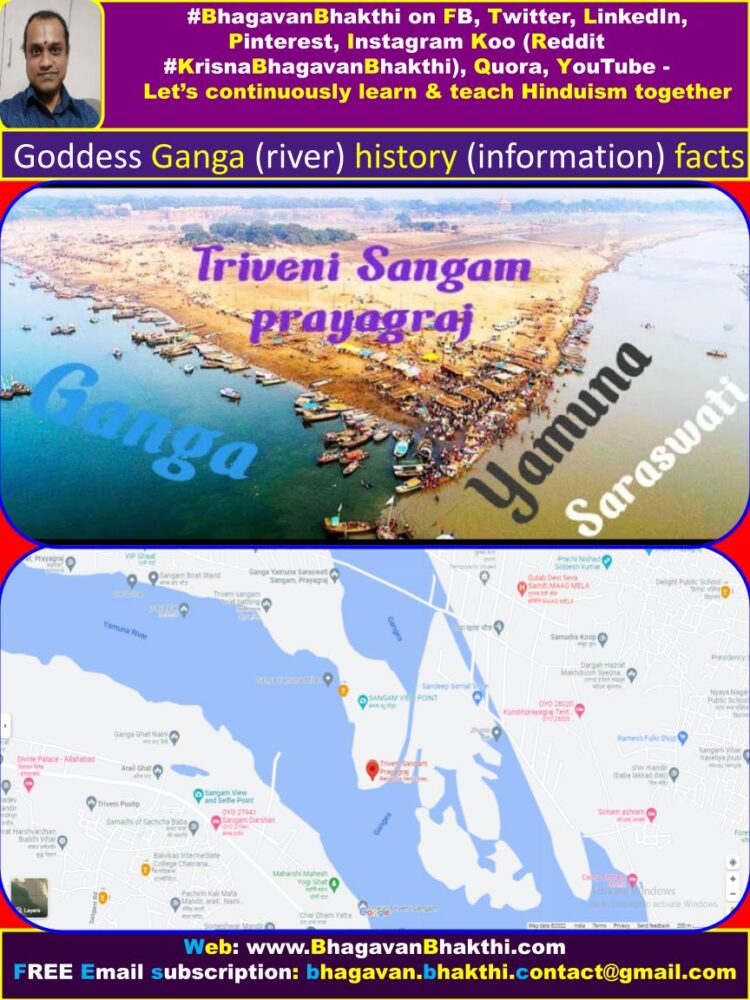
List of Goddess Ganga (river) history (information) facts are as given below:
Takes birth from Sri Hari (Vishnu) foot, Stays in Kamandala of Sri Brahma Deva, Sits on head of Lord Shiva, Tapasya by Bhagiratha,
Attains perpetual good health, Emerging from foot of Lord Vishnu, Yamuna daughter of Lord Surya, Thinking all pain is relieved, And many more…
1. Ganga takes birth from Lord Sri Vishnu foot : The main reason is that Ganga is the daughter of svayam (directly) Lord Sri Vishnu (Vamana) (Narayana) (Hari).
Goddess Ganga gets birth from the foot of Lord Sri Vishnu. What punya (good deeds) would Goddess Ganga Devi had done to be born from the foot of Lord Sri Vishnu.
This is the most important reason that river Ganga is the most pavitra (Divinely pure) river on this earth.
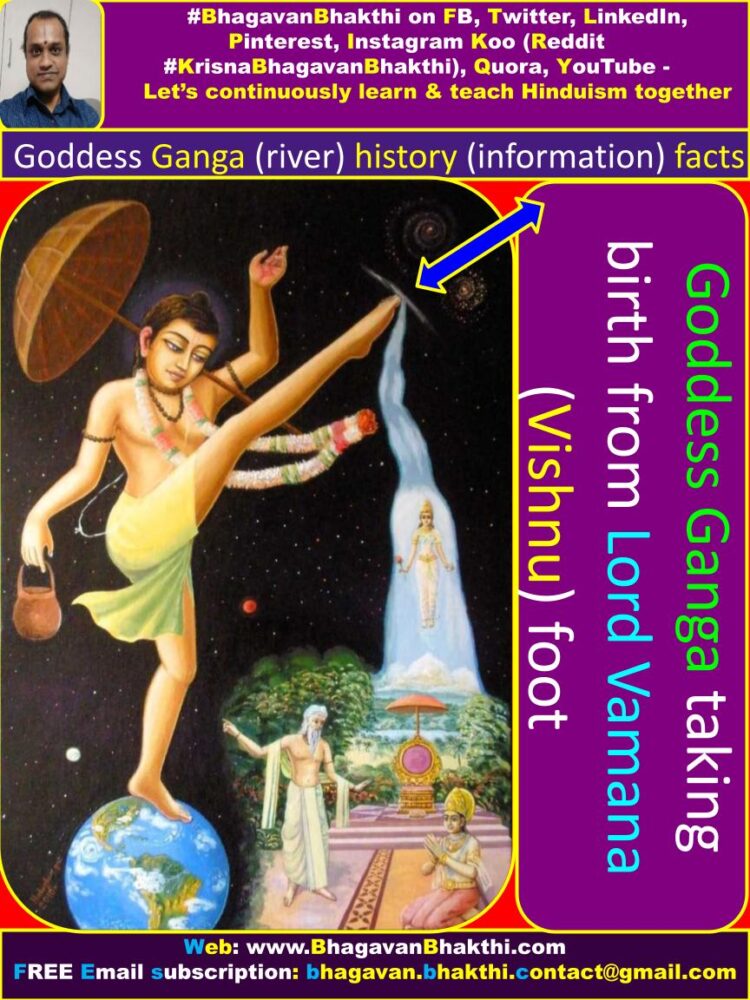
2. Ganga stays in Kamandal (Kamandala) of Lord Sri Brahma Deva : The second most reason is that –
after Goddess Ganga (river) takes birth from the foot of Lord Sri Vishnu, she goes and take rest in the kamandala (A type of divine pot) of Lord Sri Brahma Deva.
This is the second most reason for Goddess Sri Ganga Devi being so sacred.
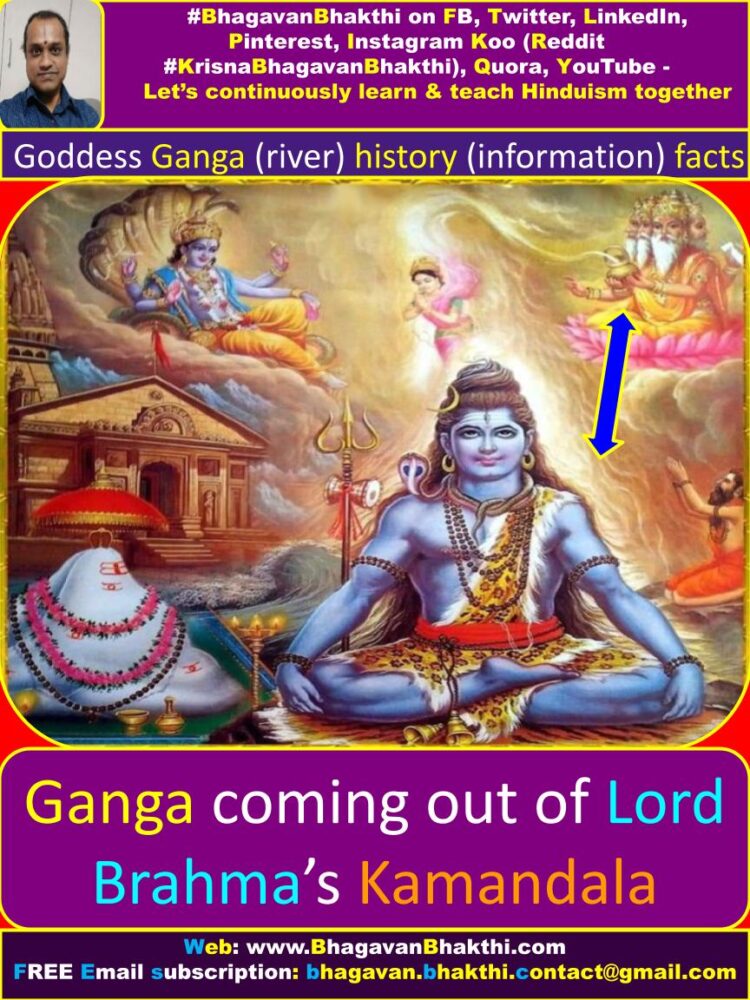
3. Ganga sits on head of Lord Shiva : The third most reason is that after the above two,
Goddess Sri Ganga Devi goes and sits on the head of the Lord Shiva (Lord Sri Rudra Deva).
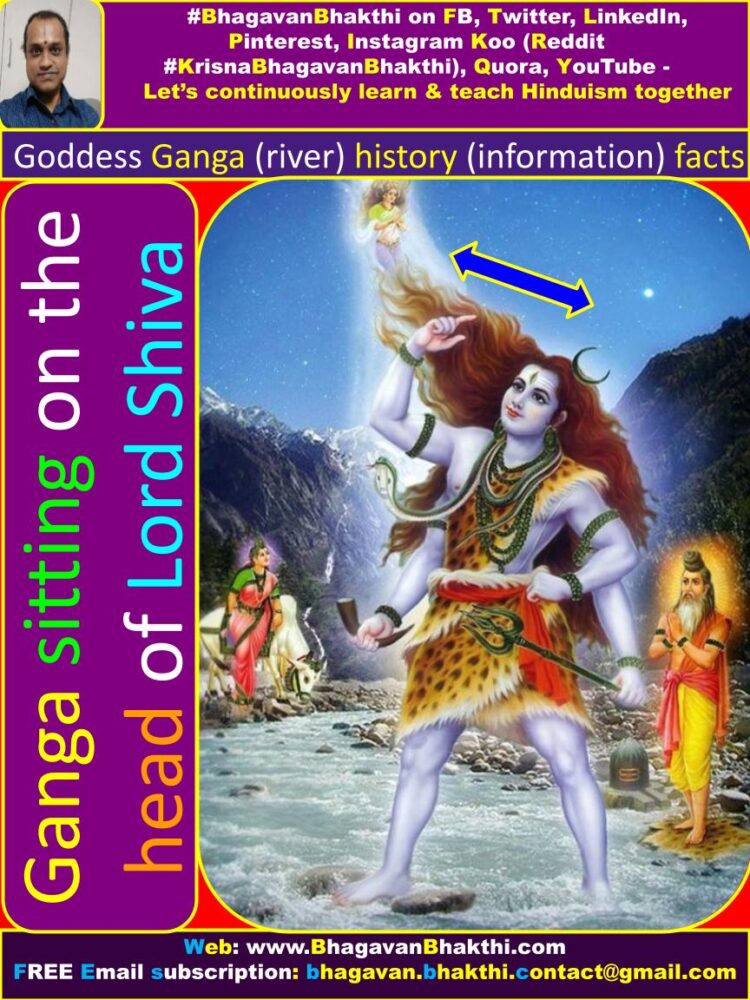
4. Tapasya by Bhagiratha : Also one of the most important reason that Ganga Devi is sacred is that –
Bhagiratha and his ancestors had performed great tapasya (penance) to bring Ganga Devi to the earth, that is, to get the mukti / moksha / salvation for about 60,000 forefathers of Bhagiratha.
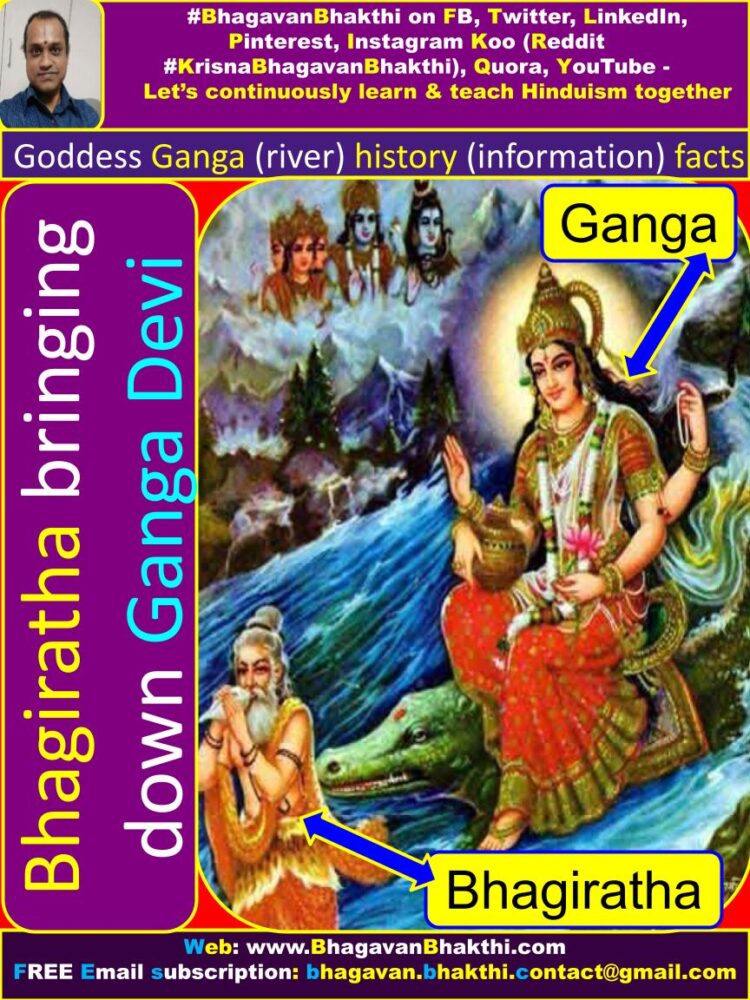
5. Attains perpetual good health : Someone who bathes in Ganga river attains perpetual good health, prospers, lives to a ripe old age and is pardoned all his sins.
Even the Devatas (Demigods) and the Rishis (Sages) are fond of the waters at this sacred confluence of Ganga,Yamuna and Saravati rivers.
6. Ganga emerging from foot of Lord Sri Vishnu : The river Ganga emerges from the feet of Lord Vishnu himself. (The story of this is related in the Brahma Vaivartha Purana.)
7. Yamuna daughter of Lord Sri Surya Deva : Goddess Sri Yamuna (river) is the daughter of Lord Sri Surya Deva (Sun God) and she is the twin sister of Lord Sri Yama Deva.
(This is related in many Puranas, such as the Markandeya Purana. Yamuna was the daughter of Lord Sri Surya Deva and Samjna.)
Such being the origins of these two holy rivers, it is but natural that their confluence should be so sacred.
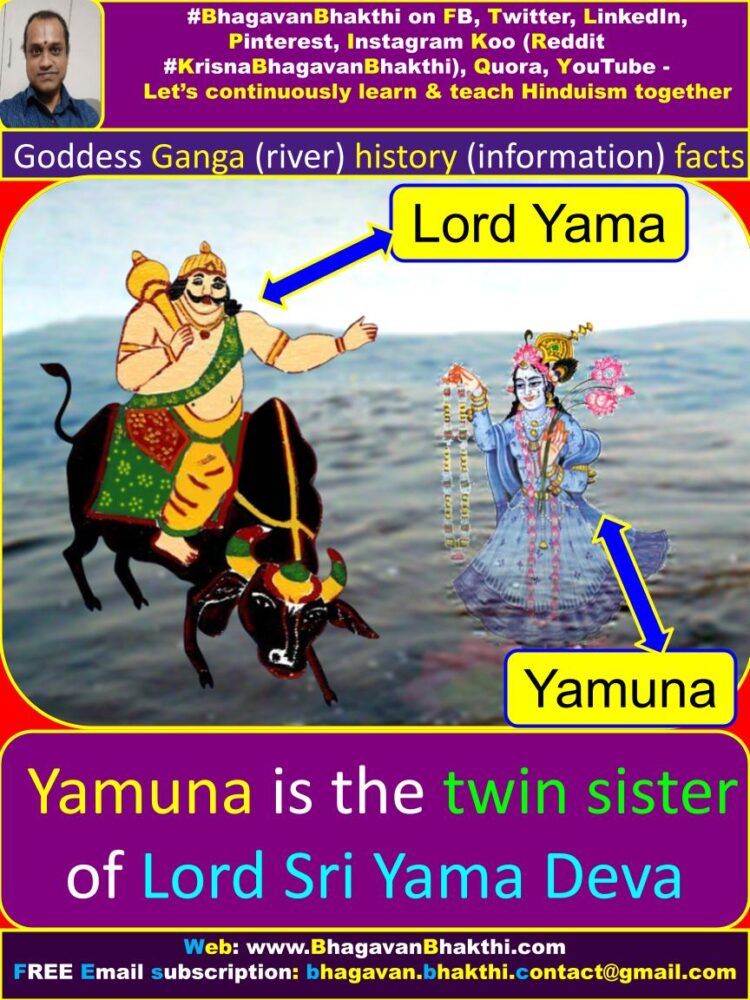
8. Thinking of Ganga Devi, all pain is relieved : In fact, the Goddess Sri Ganga (river) is so sacred that even if one just thinks of her, all pain is relieved and all sins are pardoned.
Along the banks of the Ganga is a remarkable tirtha (pilgrimage place) known as Prayaga (Prayag) (प्रयाग) (prayāga). (Today it is called as Prayagraj and it is located in Uttar Pradesh district.)
Lord Sri Brahma Deva himself performed a yajna (sacrifice) there. You can bathe in the waters of all the tirthas if you so desire.
But the punya (store of merit) that you will acquire from other river(s) is only a sixteenth of the punya you will acquire from touching a few drops of water from the Ganga river (Ganges).
A person who anoints his head with mud taken from the banks of the Ganga river (Ganges) becomes like Lord Shiva himself.
There are three objects that are sacred to Lord Sri Vishnu as given here: The Ganga river, the Tulasi (basil) plant and dust from the foot of a devotee of Lord Sri Vishnu.
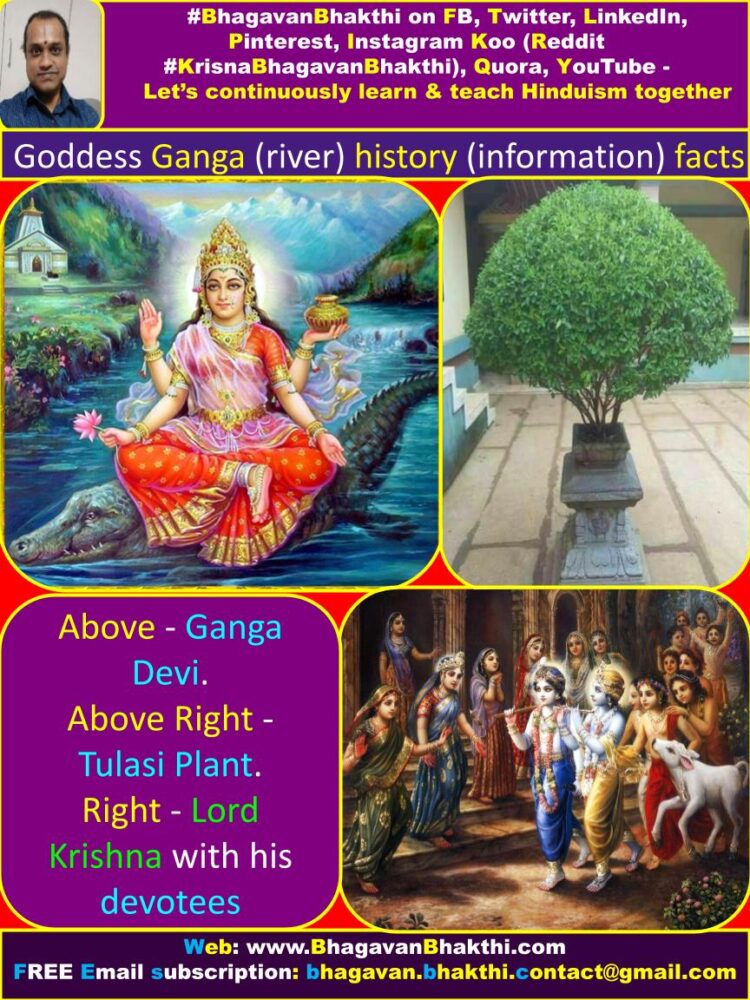
Information about the importance of Ganga river to Hindus is as given below:
The Dharmic (riligious) significance and importance of Ganga River is established at the origin itself, that is, the Gangotri is the spot of origin of River Ganges.
Many pilgrimage places (Tirtha Sthalas) for the Hindus are settled along the banks of River Ganges.
The Hindus Dharmically (religiously) worship the river Ganga river (Goddess Sri Ganga Devi).
Situated on the banks of River Ganges, Varanasi (Kashi) is considered by some to be one of the most holiest city in Hinduism (Sanatana Dharma).
Haridwar and Prayagraj [In ancient times this place was called as Prayaga (Prayag) (प्रयाग) (prayāga)] are also on the banks of Ganga.
These Two Cities (Haridwar and Prayagraj) are divinely world famous for or Kumbh Mela festival.
Kumbh Mela is one of the worlds largest human gathering on planet Earth. (Usually human gatherings will be in millions and crores.)
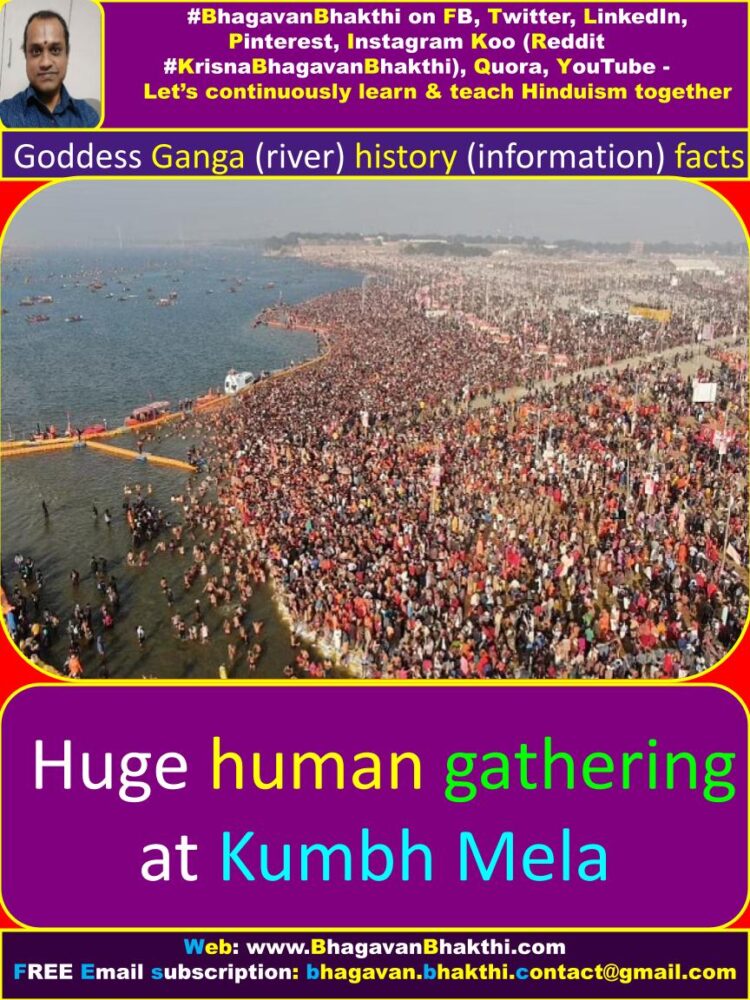
People travel from distant places to immerse the ashes of their kin in the waters of the Ganga. This immersion also is believed to send the ashes to higher planets like Svarga Lova (Heaven), etc..
Is believed that drinking water from the Ganga river at one’s deathbed enables him or her to attain mukti / moksha / salvation.
River Ganga is mentioned in the Rig Veda (ऋग्वेद) (r̥gvēda), the earliest of the Hindu scriptures (texts).
It is found and mentioned in the Nadistuti (नदिस्तुति / ನದಿಸ್ತುತಿ / nadistuti), which lists the rivers from east to west.
Information about the importance of Ganga River (Goddess Sri Ganga Devi) to Indians is as given below:
a. Ganga river is the largest river in terms of basin area in India, an area of approximately 10,00,000 sq. kms.
Ganga has its basin area spread along 11 north Indian states.
b. The geography of River Ganges is apt for harvesting a wide variety of crops through out the year.
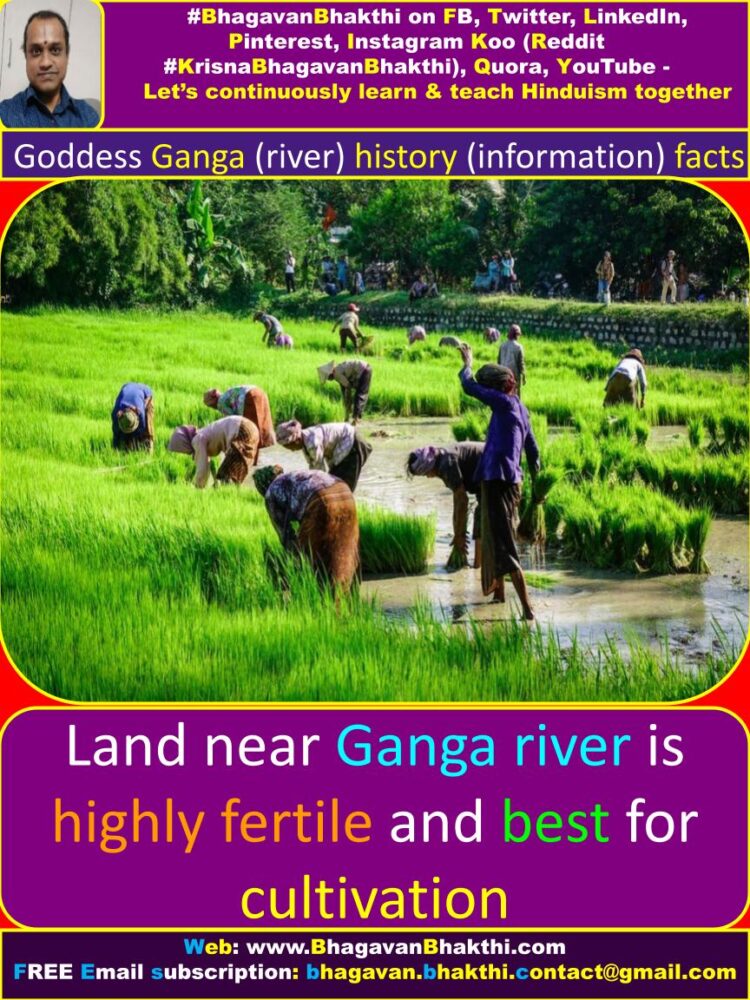
c. The Ganges Basin with its fertile soil is influential to the agricultural economies of India and Bangladesh.
d. The Ganges and its tributaries provide a constant source of irrigation to an extensive area.
The major crops cultivated in that area include rice, lentils, sugarcane, potatoes, oil seeds and wheat.
e. Along the banks of the river, the existence of swamps and lakes provide a rich fertile area for crops like legumes, chilies, sesame, mustard, sugarcane, and jute.
f. There are also many fishing zones along the river, though all of them are highly polluted in today’s time.
g. There are some other rivers also in which the Ganga is always present.
h. Their names are Godavari, Sarasvati, Kalindi, Kaveri, Krishna, Reva, Vahuda, Tungabhadra, Bhimarathi, Netravati, Tamraparni and Shatadru.
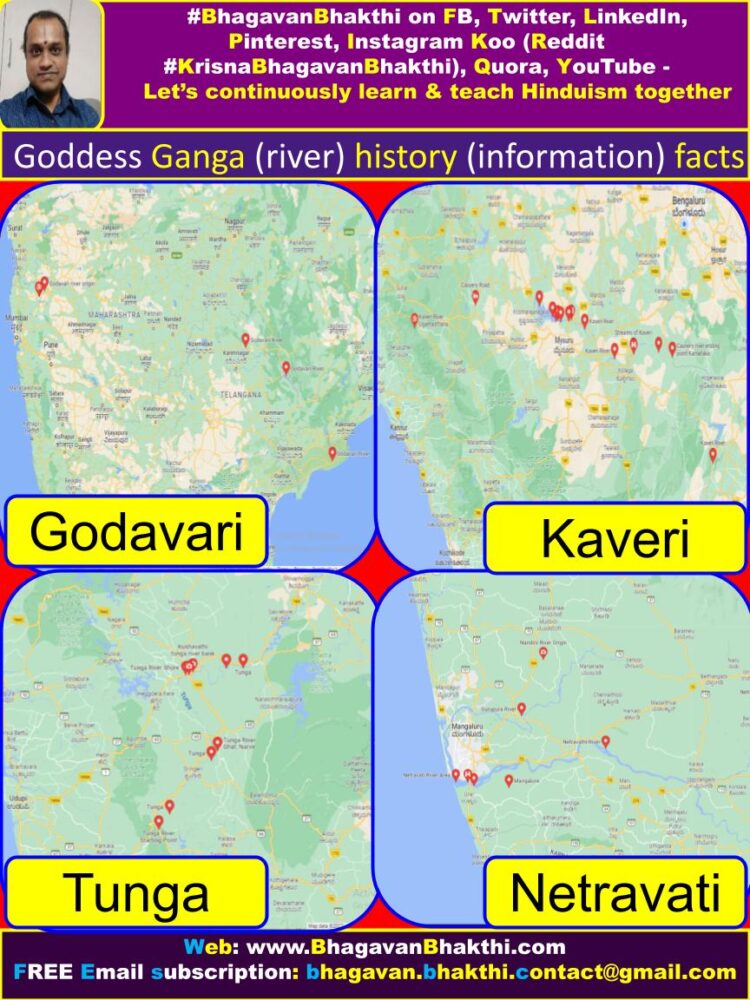
Where do the bones immersed in the Ganges (Ganga river) go?
Patitapavani Sri Ganga Devi is called as Daivi Nadi (Goddess River), because according to the scriptures, Goddess Sri Ganga Devi came from Svarga Loka (Heaven) to earth.
It is believed that Ganga (Goddess Sri Ganga Devi) has descended from the foot of Lord Sri Vishnu and has settled in the Hairs (Jata) (जटा) (jaṭā) of Lord Shiva.
Ganga (Goddess Sri Ganga Devi) is said to be Pavini (पाविनी) (pāvinī) (the one who clears out all our sins).
It is believed that a bath in the Ganges (Ganga river) destroys all sins of humans.
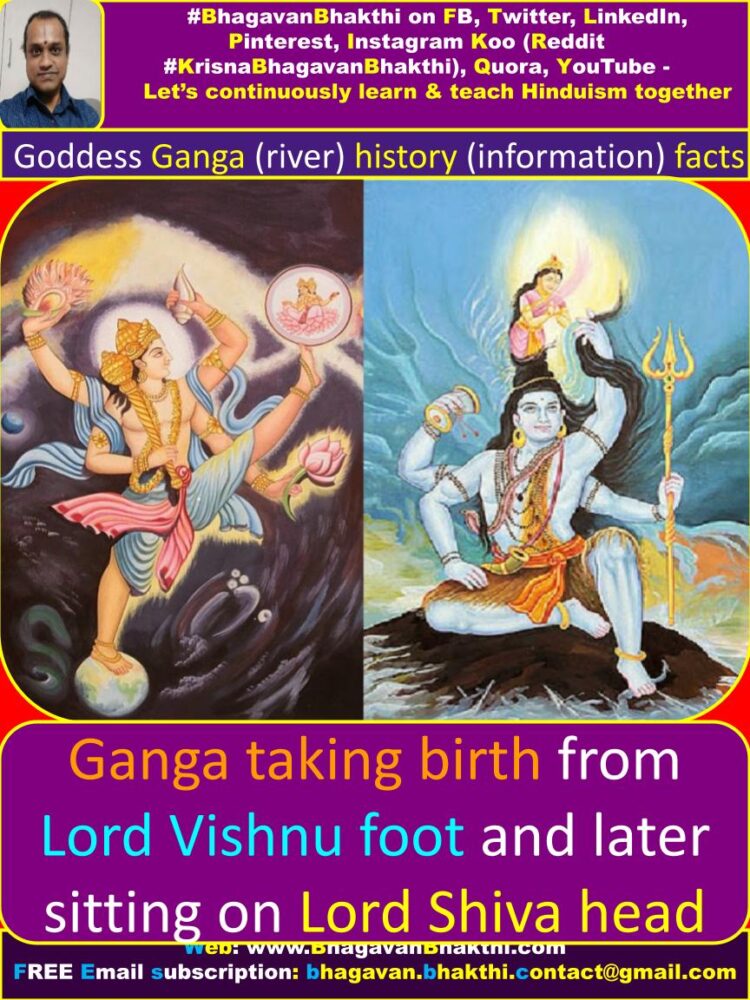
One day Goddess Sri Ganga Devi went to ‘Vaikuntha Dhama‘ (The most divine abode of Lord Sri Vishnu) to meet Lord Sri Vishnu and said to him like this:
“Bhagavan, taking a bath in my water destroys the sins of all, but how will I bear the burden of so many sins?”
Goddess Sri Ganga Devi continued like this: “How will I end the sins that are contained in me?”
On this, Lord Sri Vishnu said like this: “Ganga! When Rishis (Sages), Sanyasis (Saints / Hindu Monks), Vaishnavas come and bathe in you, all your sins will be dissolved.”
The river Ganges is so sacred that every Hindu has the last wish to immerse his / her bones in the Ganges.
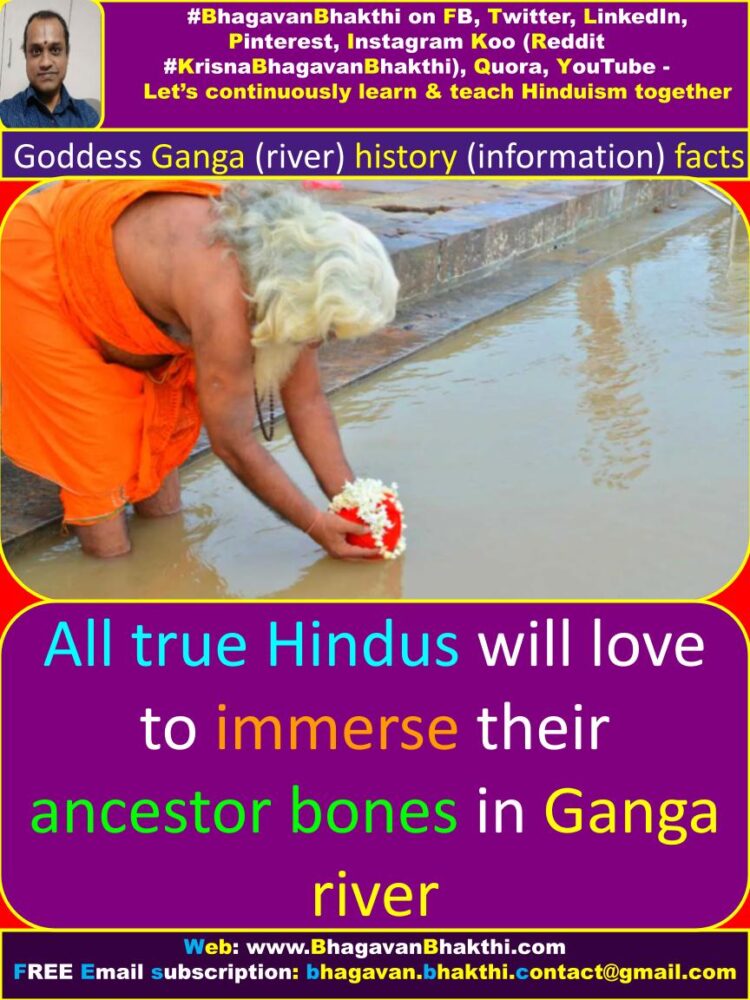
Where do the bones go after immersing in Ganga river?
Scientists could not even answer this, because even after immersing the bones in innumerable quantities, the Ganges water is pure and holy.
Even after searching the Gangasagar (Ganga river), the question could not be overcome.
According to the belief of Sanatana Dharma, immersion of the dead person’s ashes in the Ganges is considered best for peace of atma (soul) after death.
These bones go straight to the foot of Lord Sri Vishnu according to the Karmas of that particular person.
The person whose end time comes near the Ganges gets posthumous Moksha / Mukti (Liberation) (A permanent place in Vaikuntha).
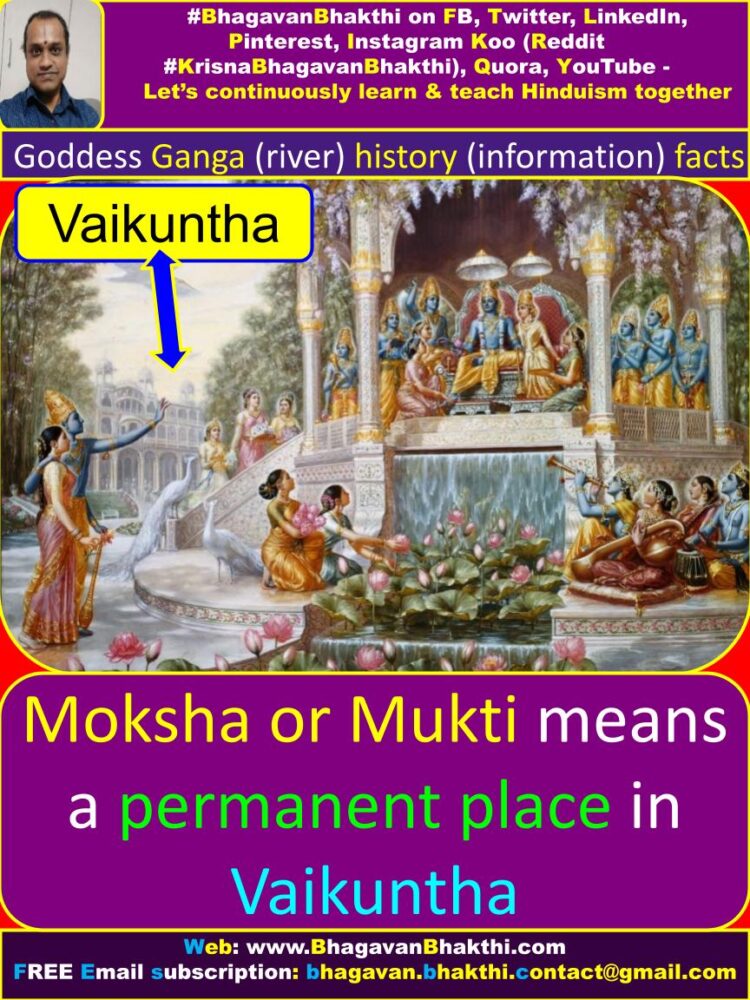
The Hindu belief in Ganga is natural with these things. This is the greatness of Goddess Sri Ganga Devi’s water, that is, Ganga River (Ganges).
Scientifically, mercury is present in the Ganges water, which causes calcium and phosphorus in the bones to dissolve in water.
Automatically, these bones will become a nutritious diet for aquatic animals in the Ganges river.
The bones contain sulfur which combines with mercury to form Paarada (पारद) (pārada) (ash).
Along with this, both of them (sulfur and mercury) form mercury sulfide salt.
The remaining calcium in the bones works to keep the water clean. In religious terms, Paarada (पारद) (pārada) (ash) (bhasma) is a symbol of Lord Shiva and Sulfur is a symbol of Goddess Sri Parvati Devi (Shakti).
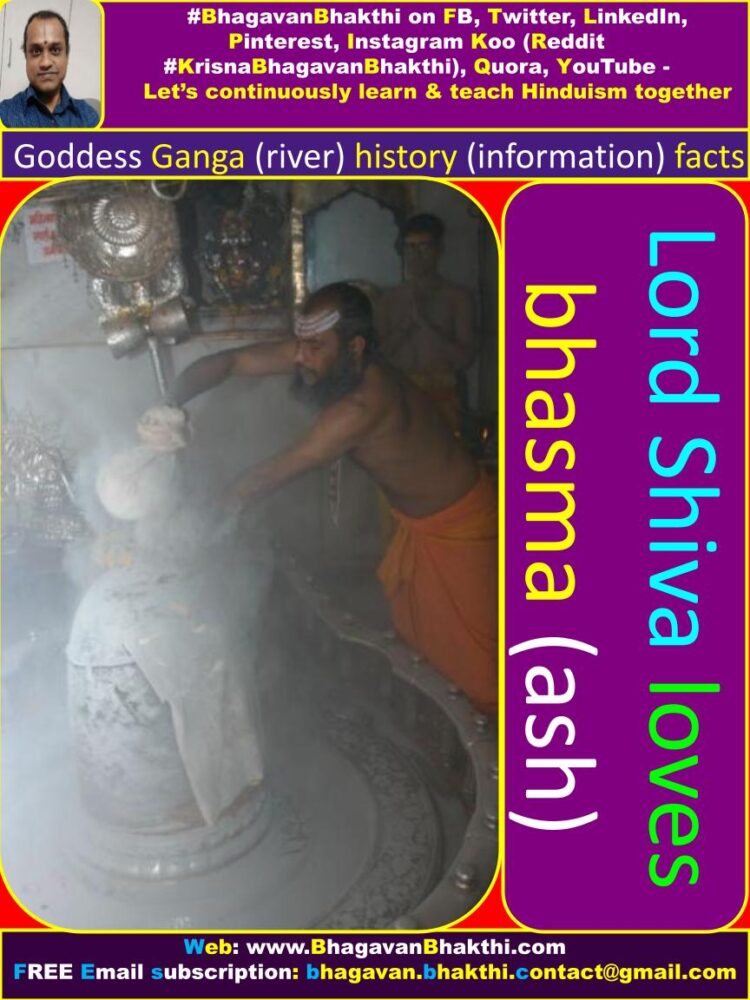
Hindu Puranas / Puranic citation and reference about Goddess Sri Ganga Devi (Ganga River) is as given below:
Sanatana Dharma’s various Shastras (Sacred scripts) including Nadi-Sukta or Nadi-Stuti (नदिस्तुति / ನದಿಸ್ತುತಿ / nadistuti) (read as Nadi / river and not as Naadi) (This is in Rig Veda).
This has been cited and referred about the greatness of Goddess Sri Ganga Devi.
Hindu Shastras / sacred granthas like Srimad Bhagavata Purana, Ramayana, Bhagavad Gita, Agni Purana,
Padma Purana, Brahma Purana etc. all have eulogized the greatness and significance and merits of Goddess Sri Ganga Devi (Ganga river).
In Hindu Shastras, Goddess Sri Ganga Devi has been very clearly mentioned in Rig-Veda that appears in the Nadi-Sukta or Nadi-Stuti (नदिस्तुति / ನದಿಸ್ತುತಿ / nadistuti).
The greatest grantha / epic on earth, that is, the Great Mahabharata took a turning point with the entry of Goddess Sri Ganga Devi (Due to a curse from Lord Sri Brahma Deva).
Goddess Sri Ganga Devi as a mortal woman married the Kuru King Shantanu (He is an avatar of Lord Sri Varuna Deva).
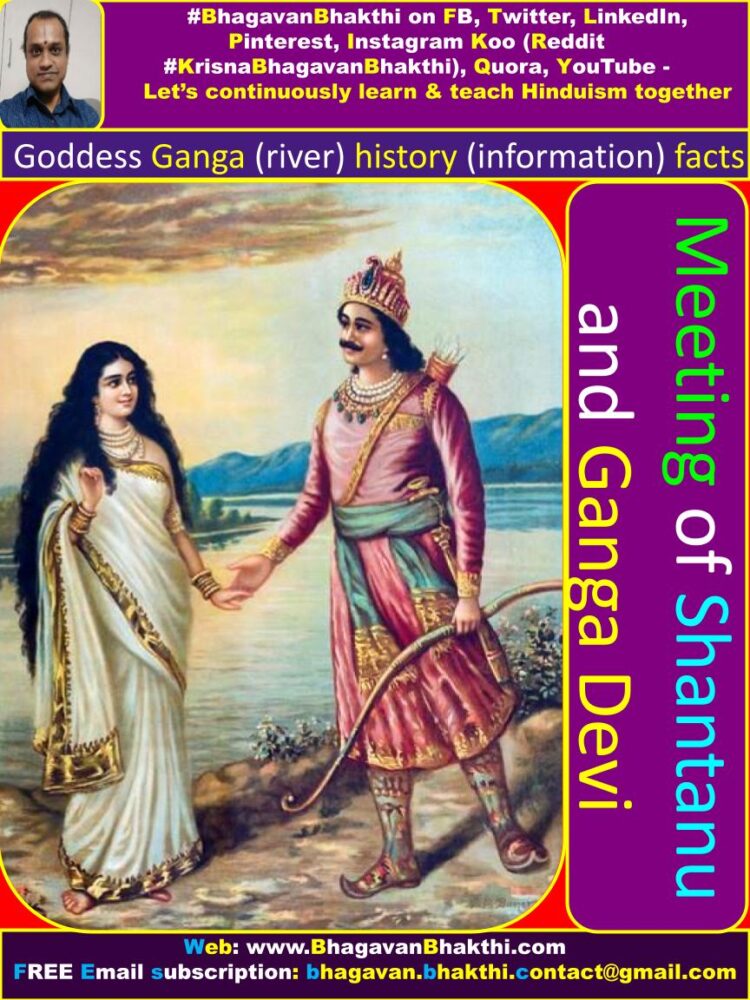
Goddess Sri Ganga Devi gave birth to ashta putras (eight sons) who were originally the ‘Ashta Vasus‘ in their earlier life.
And the 8th child was the hero of the Epic Mahabharata, that is, Devavrata or Bhishma Pitamaha.
Devavrata or Bhishma is also known as Gangeya (गांगेय / ಗಾಂಗೇಯ / gāṅgēya) or Ganga-Putra, as he was born from Goddess Sri Ganga Devi (mother).
In the great epic Mahabharata Bhishma explains the greatness, glory and great significance of Goddess Sri Ganga Devi to Pancha Pandavas when lying on the ‘sharashaiyya‘ (bed of arrows).
In the great epic Mahabharata, we find Arjuna extracting water from ‘Patala Ganga‘ with his arrow.
This was done by Arjuna to quench the thirst of Bhishma Pitamaha (Here Pitamaha means, the great great grand father in Sanskrit).
During the days of Vaidika (Vedic times), Rishis (Sages) used to have their ashrama (ashram) / hermitage on the banks of rivers, especially on the banks of Ganga River.
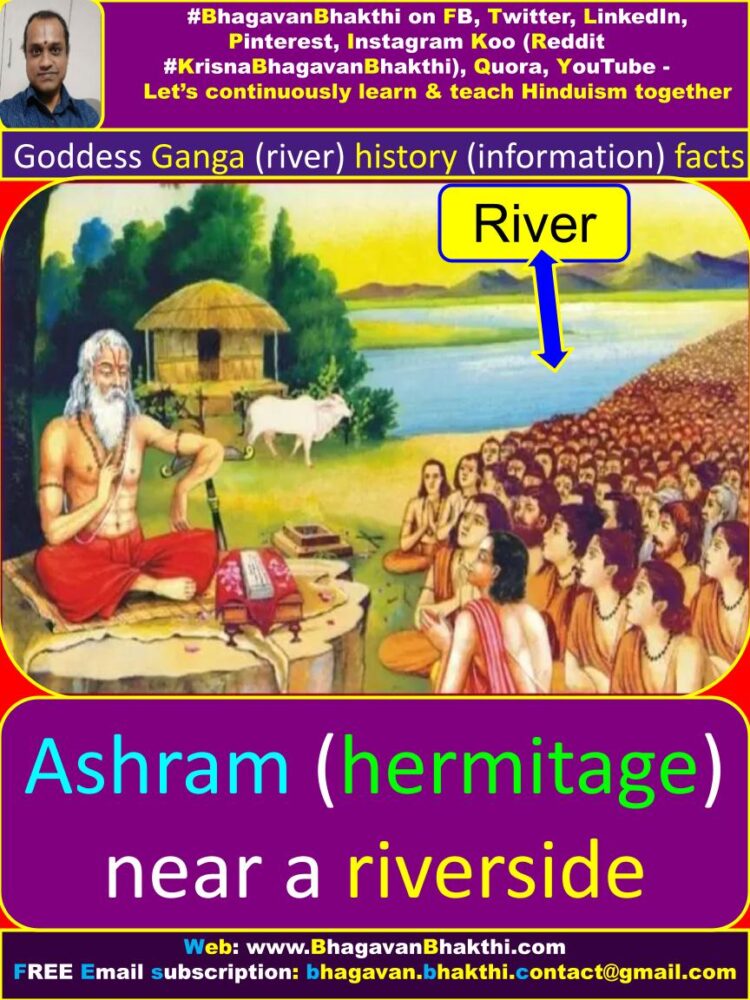
Even in today’s times, many Sadhus / saints live on the banks of Ganga River.
One very good example is of the Rishi (Sage) Valmiki had his ashram on the banks of river Sri Ganga River.
This ashram (hermitage) place was known as Brahmavarta. Here Lord Sri Brahma Deva had performed ‘Ashwamedha Yagna‘.
In another Hinduism’s great Epic Ramayana, the avatar of Goddess Sri Mahalakshmi Devi, that is –
Sri Sita Devi during her exile lived in the Ashram (hermitage) of Rishi (Sage) Valmiki on the banks of river Ganga River.
Various Hindu pilgrimages (sacred places) and divine pilgrimage centers located at the riverside of Ganga River are as given below:
Badrinatha (Badrinath), Kedaranatha (Kadarnath), Rishikesha (Rishikesh), Haridwara (Haridwar), Kaashi (Kashi), Bithoor (Bithur), Prayagraj, etc.
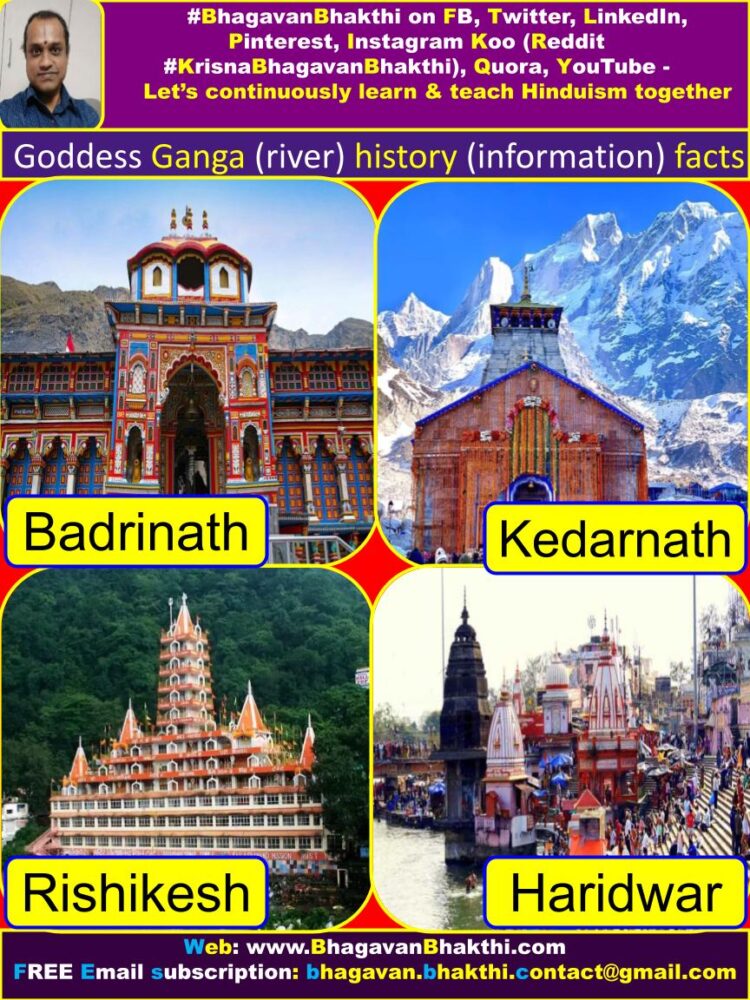
All these are located on the banks of river Ganga river itself
The Bindusar near Gangotri is the same place and spot where Bhagiratha Maharaja performed his tapasya / penance for the descent of the ‘Goddess Sri Ganga Devi‘.
Famous temple like Badrinatha (Badrinath) is on the banks of river ‘Alakananda‘, this is, one of the six head streams of Ganga River.
The place where Ganga River meets Yamuna and Saraswati has become a famous pilgrimage center called Prayagraj (Originally called as Prayaga or Prayag), that is, it is called as the Tirtharaj.
(Her Tirtharaj means – The king of all the Tirthas / rivers).
Gangasagar, the island at the mouth of Ganga River is said to be the location of Rishi (Sage) Kapila‘s ashram (ashrama) / hermitage is present.
This is associated with the tapas / penance of Bhagiratha Maharaja and caused the descent of Goddess Sri Ganga Devi (Ganga River) from Svarga Loka to earth.
[Rishi (Sage) Kapila (Muni) is an avatar (incarnation) of Lord Sri Vishnu.)
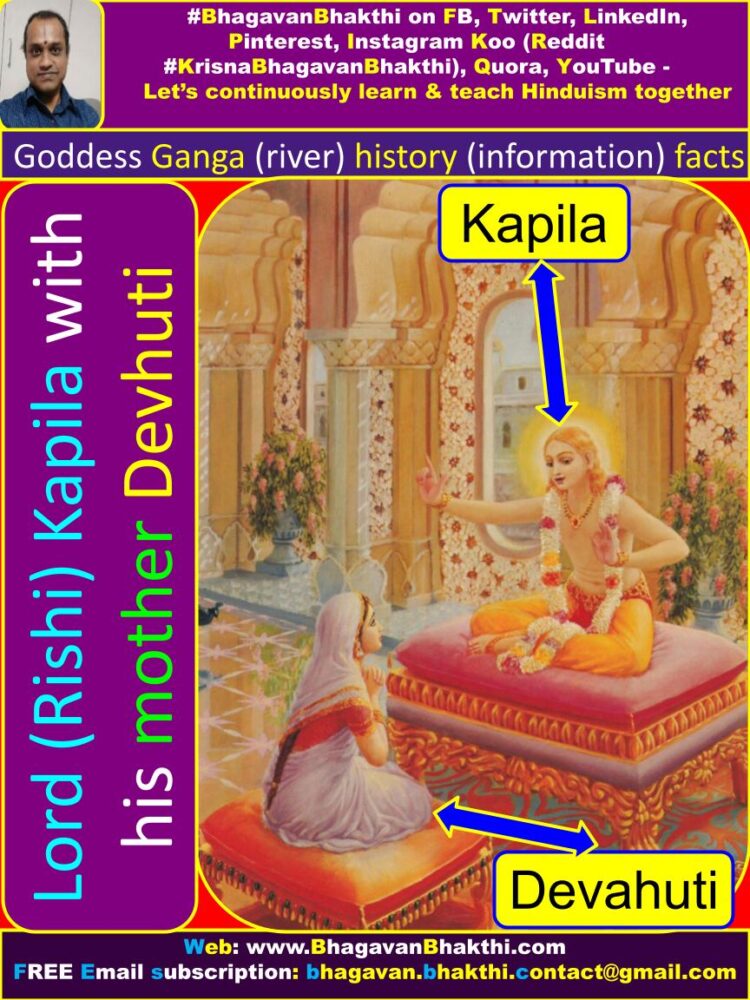
Symbolism of Goddess Sri Ganga Devi (River) is as given below:
As said in Dharma Sindhu, Goddess Sri Ganga Devi is depicted as follows:
Chaturbhuja (four hands) – Four arms, Water Pot (Kalasha) in one hand, Kamala / Lotus in the second hand. The third hand is in the form of Varada mudra.
Fourth hand shown as an Abhaya mudra. Goddess Sri Ganga Devi is mounted on a white Makara / Crocodile as her pedestal.
Goddess Sri Ganga Devi is symbolized having ‘trinetri’(three eyes). Goddess Sri Ganga Devi is having Chandra / Moon on her forehead and thus she is known as ‘Chandrakala’.
Goddess Sri Ganga Devi is wearing white silk attire. Goddess Sri Ganga Devi always has the auspicious glimpse on her daivi / divine face.
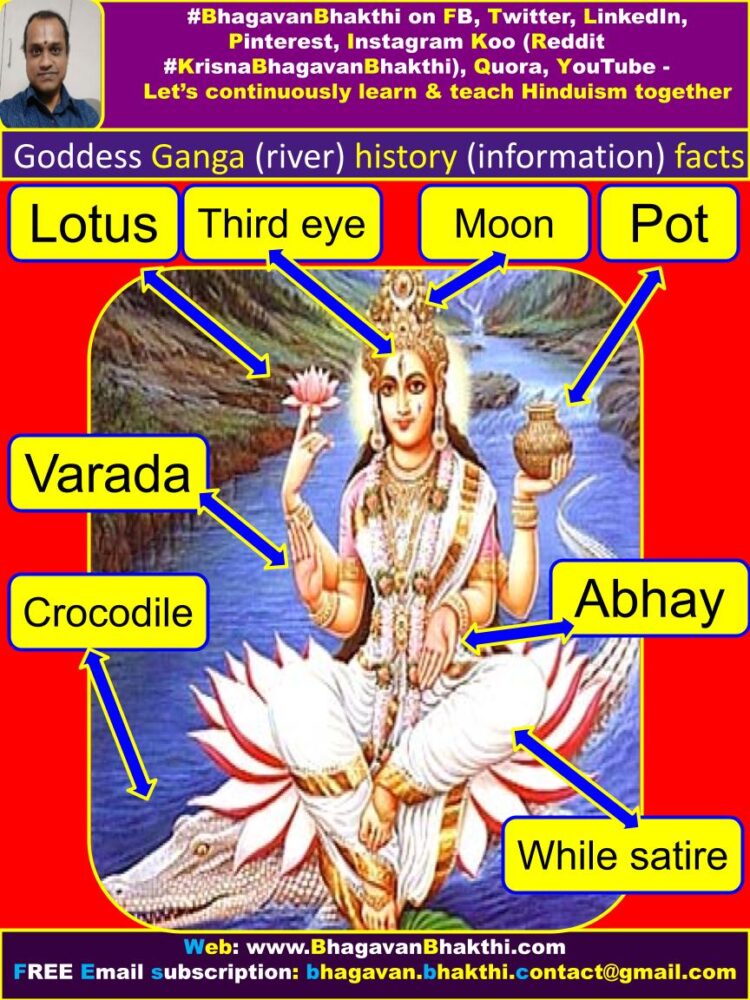
Dharmic (religious) and Spiritual significance Goddess of Sri Ganga Devi (Ganga River) is as given below:
Sanatana Dharma people will always be be eager and longing to have a darshan (darshanam) (A divine glimpse) of Goddess Sri Ganga Devi (Ganga River).
And also will be whole heartedly wishing to take a bath in the daivi / divine river of Goddess Sri Ganga Devi (Ganga River) at least once in their life time.
Also the Sanatana Dharma people will love to die on the banks of river Goddess Sri Ganga Devi (Ganga River) which is considered as highly sacred.
To pour Ganga River’s water into the mouth of a dying person is a custom among the Hindus.
We find people in Hindu Dharma immersing ashes (mortal remains) of the deceased in Ganga River with a belief that the deceased atma / soul will attain moksha / salvation.
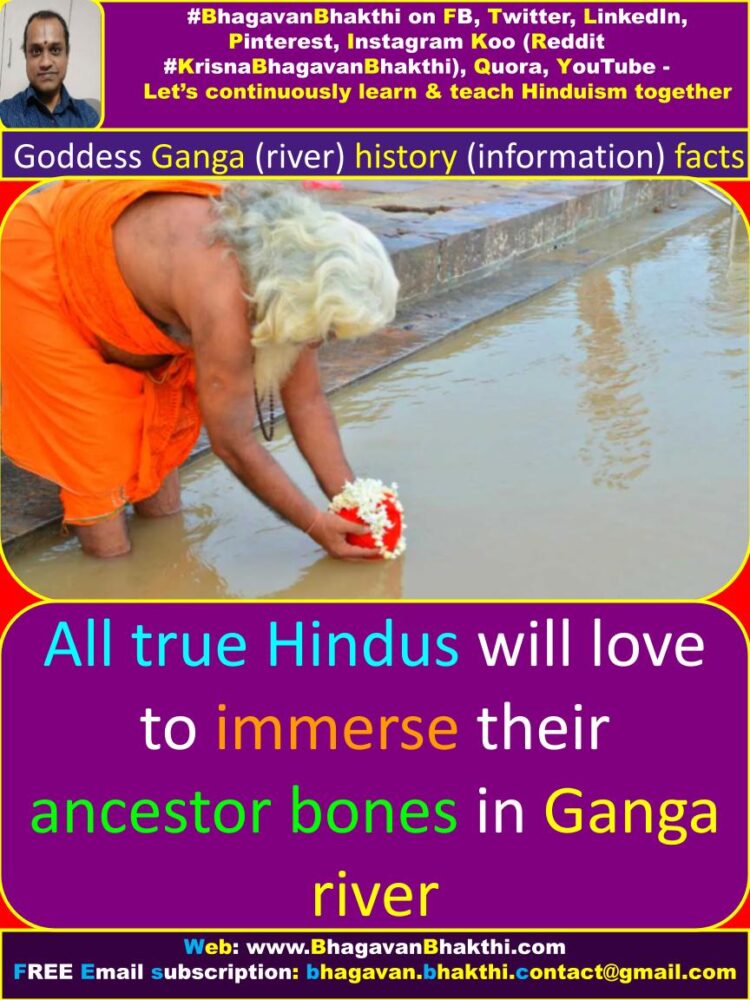
It is said that the very sparsha (touch) of river Ganga will sanctify seven generations on both sides (maternal and paternal).
Taking bath in Ganga River especially during Parva Kaala (Kaal) like : Uttarayana (Uttarayan), Dakshinayana (Dakshinayan), Grahana (Grahan) / eclipse days, Pushkar (Pushkara) is highly auspicious / meritorious and helps in remission of all our paapas / sins.
Even today, every day thousands and lakhs of Hindu people take bath in the Great Ganga River at various places all over India.
Several lakhs and millions of people recall Goddess Sri Ganga Devi in various Dharmic / religious ceremonies and rituals.
We find invariably Hindu families keeping Ganga water in their houses as an auspicious and Dharmic symbol.
Ganga river’s water is collected from places like Haridwar, Rishikesh and Kashi etc. and stored in copper or brass pots sealed with tight lid.
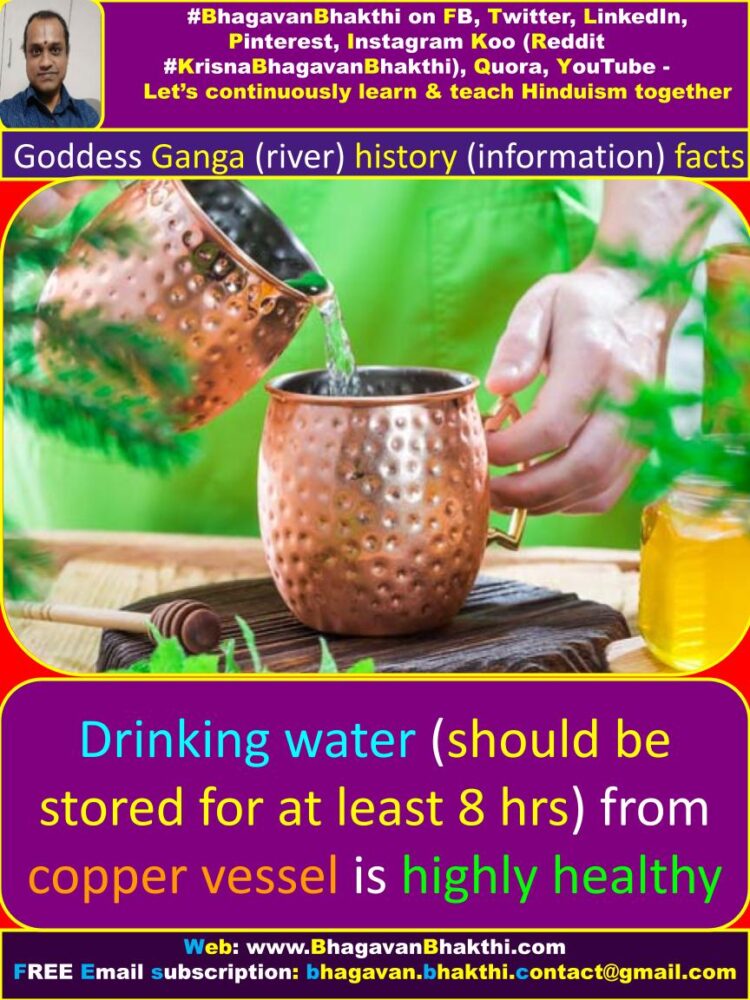
Ganga river’s water is attributed with the highest quality of purity and is considered to remain pure over a period of time.
It is said in our Shastras (Hindu Texts) that Ganga river’s water has ayurvedic / medicinal properties that cure the various ills.
Dharmically (religiously) and spiritually, taking a bath in the most auspicious and sacred Ganga River:
Is said to be atma / soul cleansing and also purifies one from his / her paapas / sins.
Ganga river’s water is considered as extremely pious and said to contain properties of Amrita (Amruta) (ambrosia / divine nectar).
Since time immemorial, Sanatana Dharmis’ (that is Hindus’) life is closely associated with the Ganga river in various ways.
No Dharmic / religious and spiritual activity in Hindu philosophy from birth until death starts without Ganga river water.
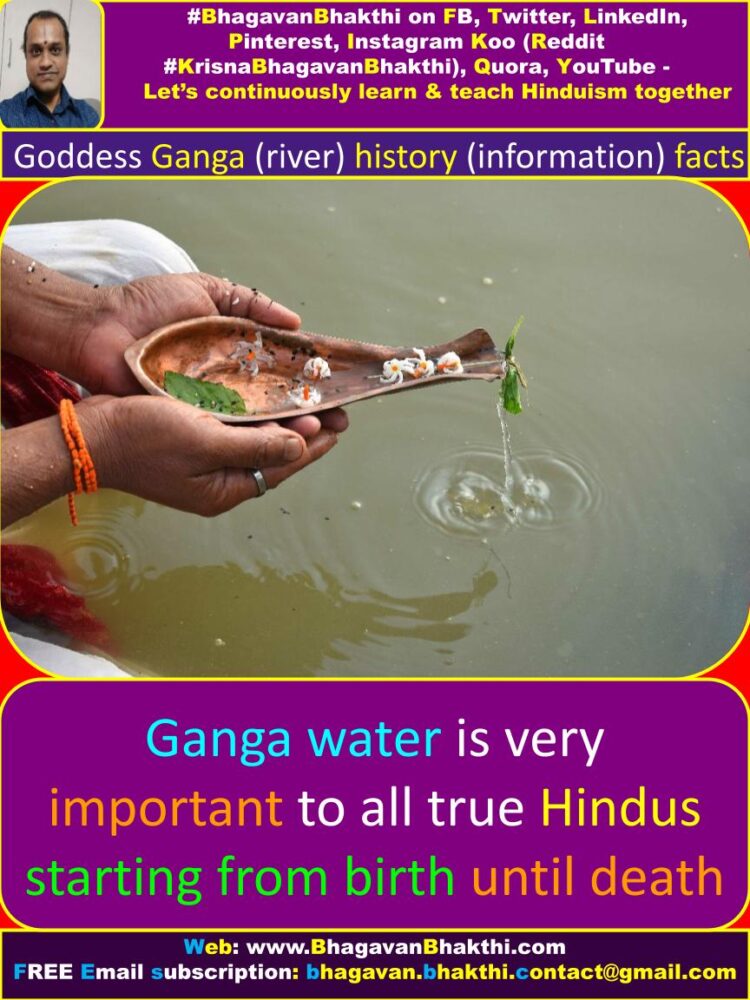
Unlimited civilizations, dynasties, epics, have originated on the banks of Ganga River.
The history of Ganga River is as old as Hindu civilization (Sanatana Dharma) itself.
Starting from its place of origin in Gangotri, right up to its merging with the Sea (Varuna Deva / Samudra Deva is Sri Ganga Devi’s husband) at Gangasagar, the entire path of Ganga River is sacred to all Hindus.
In places like Kashi, Haridwar and Rishikesh, we find bhaktadis / devotees offering ‘arati‘ to Goddess Sri Ganga Devi in the evening by singing devotional songs, which is a sight not to be missed.
An important custom river to Ganga River among Hindus is as given below:
There is also an old custom among Sanatana Dharmis (Hindus), that they bring Ganga water from Kashi.
And perform Abhisheka to Lord Shiva at Rameswaram Jyotirlinga installed by Lord Sri Rama.
And collect the sand from the sea (Indian Ocean) at Rameswaram.
And immerse it with Ganga water with a belief that it is a completion of the pilgrimage cycle.
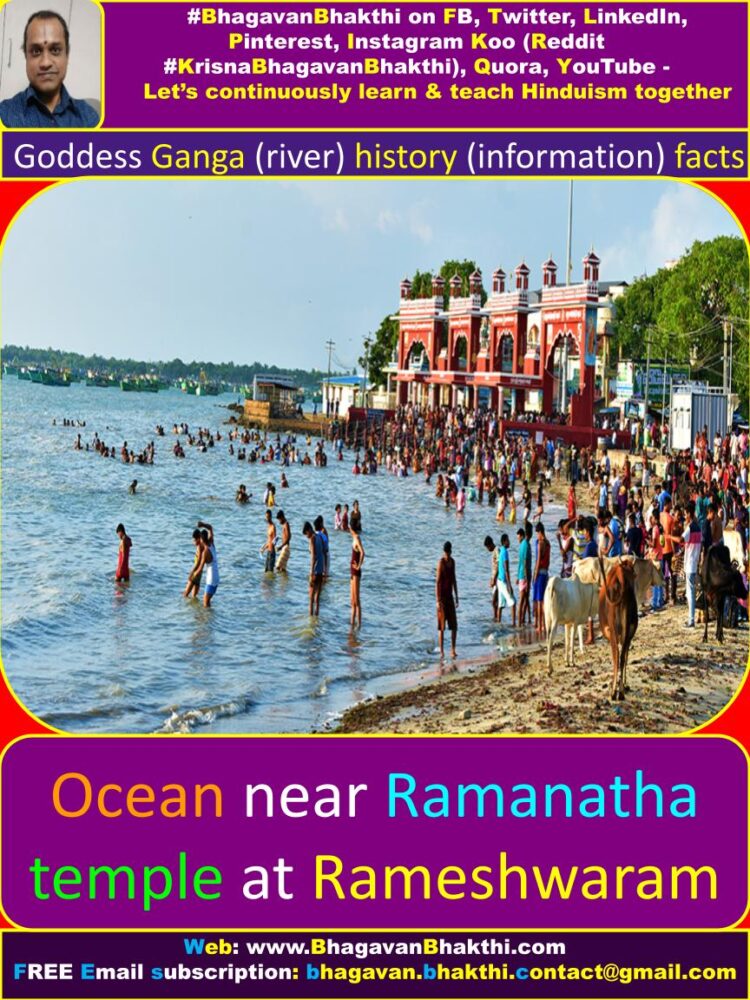
Perhaps no other river has found as much reference as the holy Ganga river (Goddess Sri Ganga Devi) in the Great Hindu Puranas.
Goddess Sri Ganga Devi (Ganga River) is in existence since the VaidikaSamayam (Vedic times).
Sometimes the piousness of Ganga water is compared with the sacred Goddess Sri Tulasi Devi (Tulasi Plant).
To count the merits of Goddess Sri Ganga Devi (Ganga River) is like counting water drops in the ocean.
Goddess Sri Ganga Devi (Ganga River) is not just a mere river alone for the pious Hindus, but it is much more than that of sacredness, celestial and divinity.
Goddess Sri Ganga Devi (Ganga River) is the Queen / Head (Prime river) of all the rivers. She is the Goddess among all the rivers on this earth.
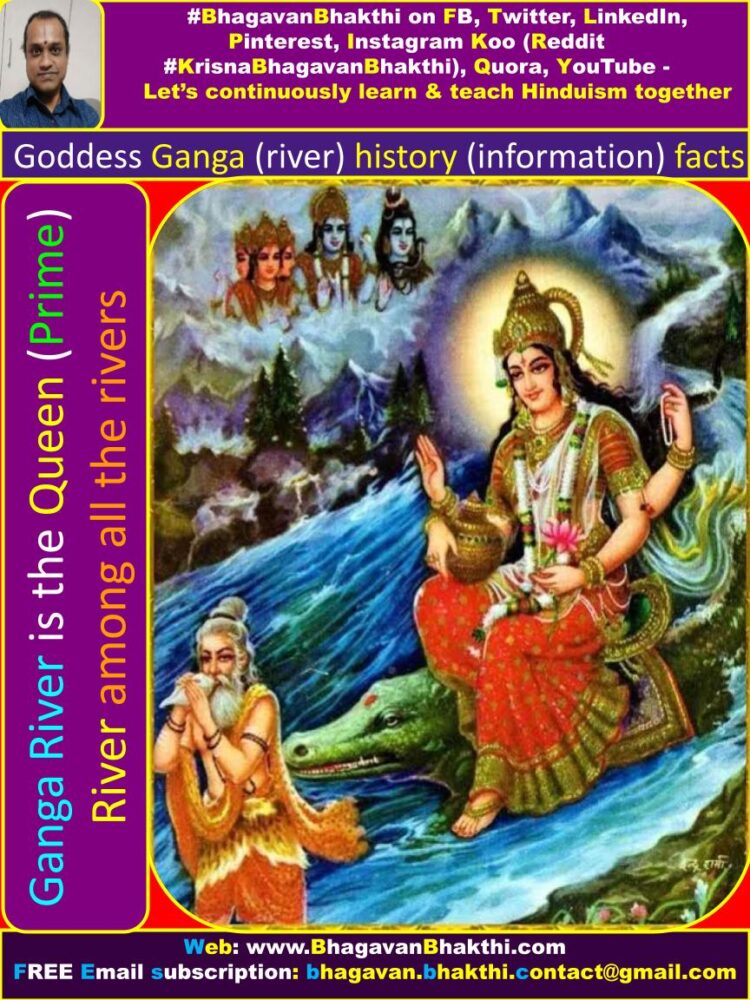
Maata (Mother) (Goddess) Sri Ganga Devi (Ganga River) is highly revered in Hindu religion (Sanatana Dharma).
That’s why even today we find people celebrating festivals relating to Goddess Sri Ganga Devi (Ganga River), that is –
Ganga Dessehra, Ganga Pushkar, Gangasagar Mela, Kumbha Mela and Gangotpatti (Jahnu Saptami).
Every year on the day of Makara Sankranti, Gangasagar Mela is held at Gangasagar.
These festival days are the best occasions to pay our reverence to Goddess Sri Ganga Devi (Ganga River) the heritage of Hindu philosophy and the National river of India.
At the same time it is also our ardent Dharma and responsibility to protect this national heritage from getting polluted.
Originated from the foot of the Supreme Lord Sri Vishnu, sanctified as sacred water in the Kamandala of Lord Sri Brahma Deva, purified with a descent on the head (matted hair) of Lord Shiva,
and came out of Sage Jahnu’s ear (Jahnavi), Goddess Sri Ganga Devi (Ganga River) is considered as the most sacred and Divine river in Hinduism.
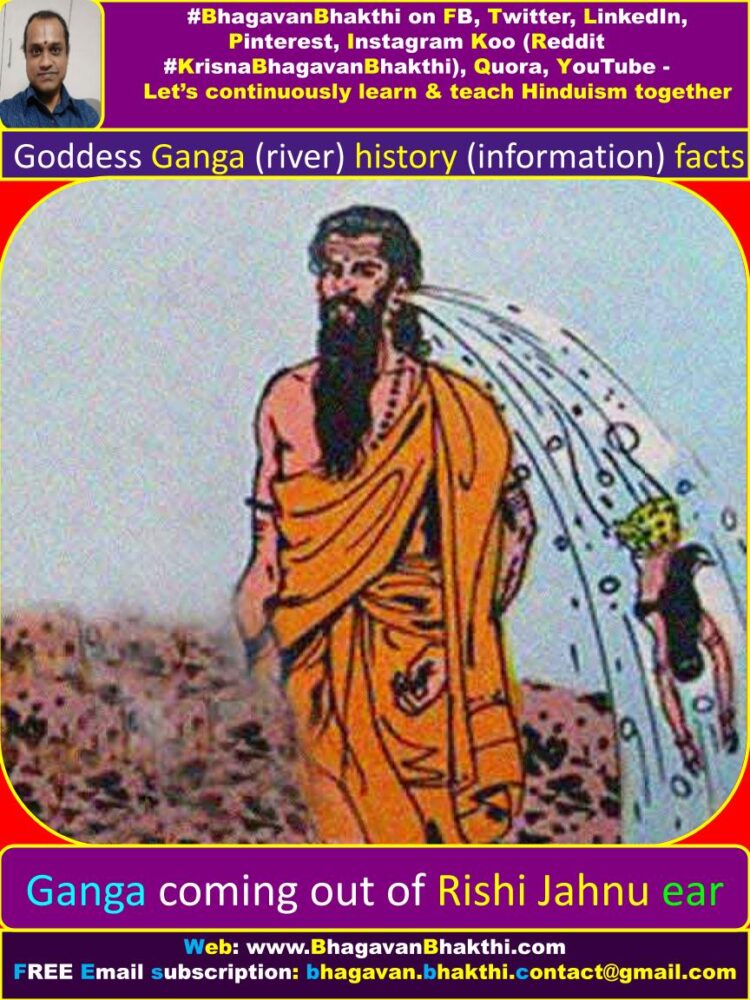
Lord Sri Krishna mentions in his famous preaching of Bhagavad Gita, that is, in Vibhuthi Yoga (10th chapter, shloka #31) says that:
“He (Lord Sri Krishna) is Jaahnavi” (Other name of Ganga) – “srotasamasmi jaahnavi” (“Among the rivers I am the Ganga“).
Perhaps we don’t need a better testimonial than this to confirm the significance, spirituality and sacredness of the great holy river Sri Ganga Devi.
Ways of worship of Goddess Sri Ganga Devi (Ganga River) are as given below:
Goddess Sri Ganga Devi (Ganga River) worship is said to be in seven ways, that is:
By calling and chanting Her name “Sri Ganga Devi”. By having darshan (darshanam) / glimpse of the Ganga River.
By doing sparsha / touching the water of Ganga River. By worshiping Goddess Sri Ganga Devi (Ganga River).
By taking bath at the Ganga River. By standing in the waters of Ganga river. By carrying clay dug out of water of Ganga river.
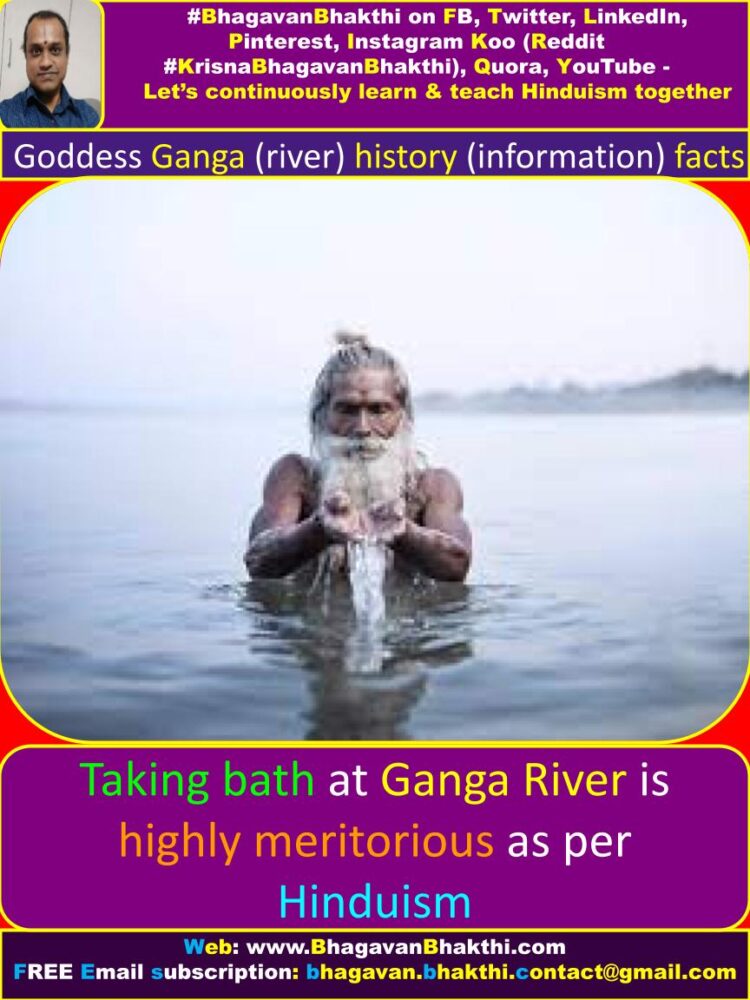
More information about Goddess Sri Ganga Devi (Ganga River) is as given below:
Origin and birth place – Gaumukha – Gangotri glacier in Himalayas in Indian sub-continent.
Merging with ocean – In Bay of Bengal at Gangasagar near Hooghly (West Bengal).
Six major head streams – Bhagirathi, Alakananda, Mandaakini, Dhauliganga, Nandakini and Pindara.
Ganga path (in countries) – India and Bangladesh. Length of the River – ≋ 1550 miles (≋ 2500 km)
States covered with India – Uttarakhand, Uttar Pradesh, Bihar, Jharkhand and West Bengal.
Major cities covered – Kanpur, Prayagraj, Varanasi, Patna and Kolkata.
Major pilgrimage centers – Kedarnath, Badrinath, Devaprayag, Rishikesh, Haridvar, Bithoor (near Kanpur), Varanasi and Prayagraj.
Pancha Prayag Kshetras (Five confluences of Ganga) – Vishnu Prayag (Dhauliganga joins Alakananda), Nandaprayag (Nandakini joins),
Karnaprayag (Pindar joins), Rudra Prayag (Mandakini joins) and Devaprayag (where Bhagirathi joins Alakananda to form Ganga river).
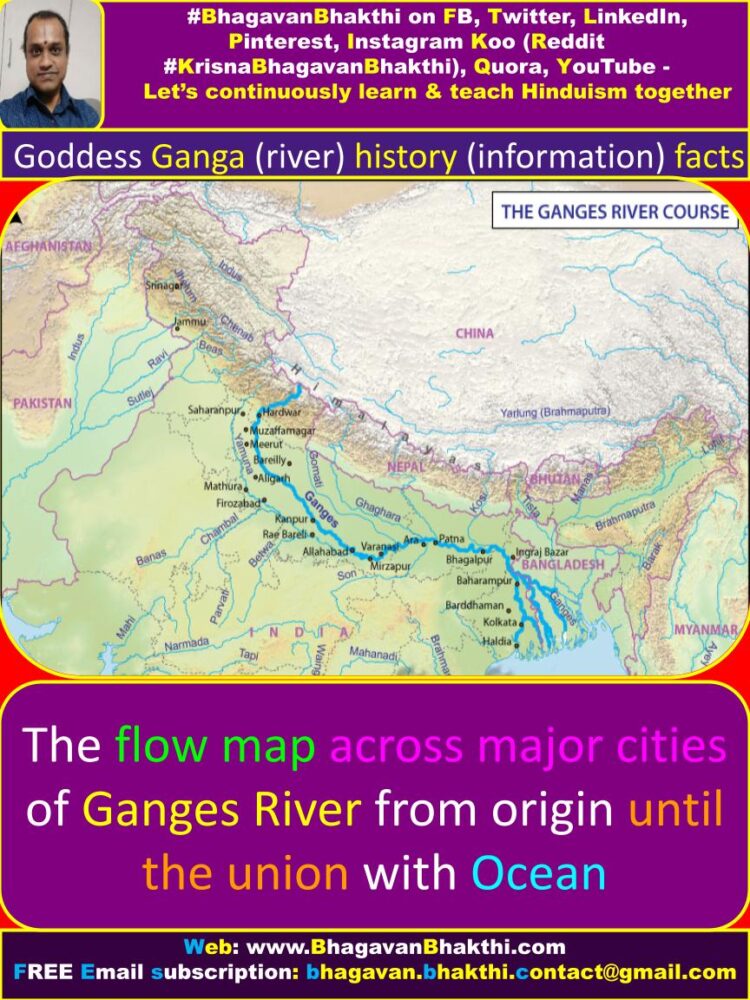
Major tributaries Ganga River are: Gomati, Ghaghara, Gandaki, Kosi, Yamuna, Son & Damodar. Ganga joins Yamuna at Triveni Sangam (Prayagraj).
Different names of Goddess Ganga Devi is as given below:
i. Vishnu Padodbhavi (विष्णु पाद्भवि) (viṣṇu pādōdbhavi) : The originating place is from the paada / foot of Lord Sri Vishnu.
ii. Surasarita (सुरसरिता) (surasaritā) : Stream of many Devatas (Demigods).
iii. Bhagirathi (भागीरथी) (bhāgīrathī) : Descended on bhumi / earth because of the tapas / penance of King Bhagiratha.
iv. Tripatagamini or Tripataga (त्रिपतगामिनी or त्रिपतगा) (tripatagāminī or tripatagā) : One who flows in all the three worlds, that is, Svarga Loka (Heaven) (Bhuvar Loka), Bhumi (Earth) (Bhur Loka) and Netherlands (Lower planets).

a. Mandakini (मन्दाकिनी) (mandākinī): In Svarga Loka / Heaven, Ganga is known as Mandakini.
b. Ganga (गंगा) (gaṅgā) : On Bhumi / Earth, Ganga is known as Ganga itself. c. Bhogavati (भोगवती) (bhōgavatī): Netherlands, Ganga is known as Bhogavati.
v. Padma (पद्मा) (padmā) : In Bangladesh, Ganga River is known as Padma.
vi. Svarga Ganga (स्वर्ग गंगा) (svarga gaṅgā) : In Svarga Loka, Ganga is called as Svarga Ganga.
vii. Jahnavi (जाह्नवि) (jāhnavi) : The great Rishi / Sage Jahnu released Ganga from his ear and thus Ganga is also called as ‘Jahnavi’.
viii. Alakananda (अलकनन्दा) (alakanandā) : One of the main head streams of Ganga near Badrinath.
(Also Alakananda means daughter of Lord Kubera. Here Alaka means a place which belongs to Lord Kubera and Nanda means daughter).

Festivals related to Goddess Sri Ganga Devi (Ganga River) are as given below:
Ganga Jayanti or Bhagirathi Jayanti : First ten days of Jyeshtha masam (month) known as Dussehra (Dasahara) is dedicated to the worship of Goddess Sri Ganga Devi (Ganga River).
Goddess Ganga Devi is believed to have descended on to the Earth on the Dashami (10th day) of Jyeshtha Masam (month), Shukla Paksha which is celebrated as Ganga Jayanti or Bhagirati Jayanti.
Kumbh (Kumbha) Mela : This mela is held on the banks of river Ganga at Haridwar and Prayagraj once in twelve years. It is also held at Ujjain and Nasik.
Ganga Pushkar (Pushkara) : This occurs once in twelve years when Brihaspati (Jupiter) enters into Mesha (Aries) rashi in the zodiac.
First twelve days and last twelve days are celebrated as Ganga Pushkar festival.
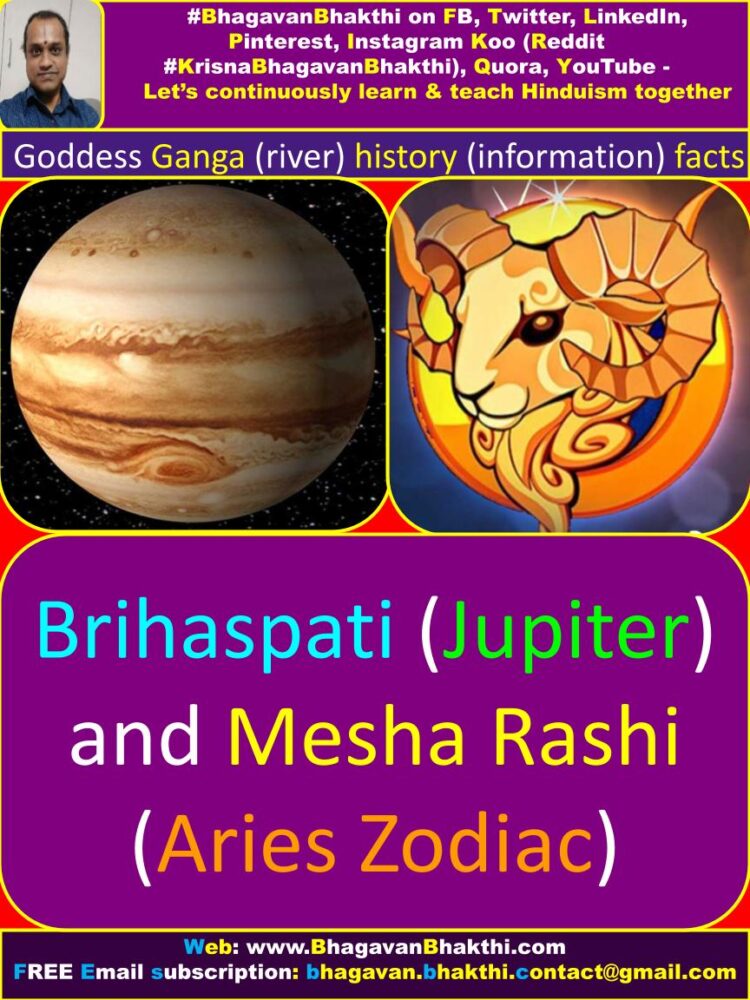
Gangotpatti (Birth of Goddess Ganga) : Saptami tithi (seventh day) in Vaishakha masam (month) is known as Gangotpatti the day on which Ganga came out of the great Rishi / Sage Jahnu’s ear and came to be known as Jahnavi.
More information will be added to this on regular, please visit after some time to know more information.
To watch videos on #Hinduism #Sanskrit language, SUBSCRIBE to my YouTube channel from this below link:
#BhagavanBhakthi YouTube channel
To know the ‘Greatness of river Narmada‘, you can click the below link given:
Goddess Narmada (river) history (information) (Significance) (importance) (facts)
To know about “Information about rivers in India“, please click the below link given:
Information, history, significance, importance, facts about rivers in India
Dear friends, if you need any clarifications about this post, kindly let me know, I will definitely try to answer all of them.
Also your one LIKE, one COMMENT, One Share, one SUBSCRIPTION is highly important.
This will help to know the quality of this content and also it will be helpful to know if any improvements is required for the content.
If you feel this content is useful to you and has helped you to improve your knowledge, kindly share this with your well-wishers.
Because “SHARING MEANS CARING”.
For receive FREE EMAIL SUBSCRIPTION about #BhagavanBhakthi, you can send an email to bhagavan.bhakthi.contact@gmail.com from your email ID.
NAMASTE!
SRI GURUBHYO NAMAHA
OM NAMO NARAYANAYA
Sri Krishnaarpanamastu
The river Godavari (western ganga) is originated from Bramhagiri mountain. Because of penance of Rishi Gautam for years to get rid off his sins of cow killing.